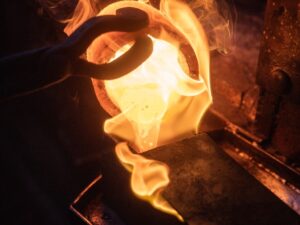Resources Top 5: Alliance woos Stellantis, absurd niobium hits, and a ‘world class’ lithium project

Pic: Via Getty
- Alliance Nickel finalises Stellantis nickel and cobalt offtake; Stellantis also snaps up 11.5% company stake
- WA1 Resources flies on more absurdly high-grade niobium drill hits at West Arunta project
- Lithium Energy is reporting “world class lithium intersections” at the flagship Solaroz brine project in Argentina
Here are the biggest small cap resources winners in early trade, Monday May 1.
ALLIANCE NICKEL (ASX:AXN)
Stellantis — which owns the Opel, Peugeot, Citroen, Fiat and Chrysler brands – is one of many top automakers inking deals direct with battery metals stocks to guarantee future supply.
Stellantis has ambitious EV targets and needs all the battery raw materials it can get.
By 2030, it expects 100% of all passenger car sales into Europe will be EVs, while in the US EVs will account for 50% of sales.
Last year, it became the second largest shareholder in aspiring geothermal lithium play Vulcan Energy Resources (ASX:VUL) with an 8% stake following an equity investment of $76m.
Stellantis has inked binding lithium hydroxide offtake agreements with VUL and another geothermal play, US-based Controlled Thermal Resources.
Today, it finalised a deal to buy ~40% of future nickel-cobalt production from Alliance Nickel’s NiWest nickel cobalt project in WA for an initial five years.
It also snapped up 15m worth of AXN shares at 18c per share, giving it a 11.5% stake in the junior formerly known as GME Resources.
The deal is “transformational” for AXN, boss Paul Kopejtka says.
“It validates our development strategy for the NiWest nickel-cobalt project and opens critical new funding options by securing a premier Tier 1 cornerstone customer and investor,” he says.
“We look forward to a long partnership with Stellantis as we continue to execute our strategy to become the next Australian supplier to the global markets of premium battery-grade nickel and cobalt sulphate.”
NiWest — next door to the largest nickel-cobalt operation in Australia, Glencore’s Murrin Murrin — will produce ~90,000 tonnes per annum of battery grade nickel and cobalt sulphate for the burgeoning EV market.
It hosts one of the highest-grade undeveloped nickel laterite resources in Australia at 85.2Mt averaging 1.03% nickel and 0.06% cobalt.
The project has a $1.2bn pricetag. A definitive feasibility study (DFS) – the most advanced of all economic studies — is on track for completion in 2023.
READ: RFC thinks these TWENTY nickel projects are most likely to attract a takeover
WA1 RESOURCES (ASX:WA1)
Arguably the hottest explorer of 2022 is flying on more absurdly high-grade niobium drill hits at the West Arunta project in remote WA.
WA1’s latest drill results from the Luni carbonatite discovery include a highlight 13m at 5% Nb2O5, within an overall interval of 31m at 3.5% Nb2O5.
This is tremendously high grade. There are three or so major niobium mines in the world; two are ‘high grade’ (between 1% and 2.5% ore grade), while the third sits around 0.5%.
Meanwhile, the Panda Hill niobium project, previously owned by Cradle Resources, had an ore reserve grade of 0.68%, while Globe Metals and Mining’s (ASX:GBE) advanced Kanyika project has a resource of 68Mt at a grade of 0.283%.
These thick, high grades from the first results for the 2023 drill program at Luni extend at least 400m east and 200m south of 2022 discovery hole LURC003 and remains open in all directions.
Confirmed mineralisation now spans 400m north-south, 400m east-west and is open in all directions.
More assays are pending.
“Drilling at Luni has quickly consolidated a shallow and extremely high-grade mineralised envelope by stepping out on a broad 200m spacing,” WA1 managing director Paul Savich says.
“Luni continues to demonstrate the potential to host a globally significant deposit of one of the world’s most critical raw materials.
“Our reconnaissance drilling, along with detailed planning for other activities including resource definition and metallurgical test work, are ongoing with further assays due in the coming weeks.”
Ferroniobium (~65% Nb), the primary saleable form of niobium, is used in steelmaking to boost strength and add corrosion/heat resistance.
300g of niobium can reduce the weight of steel in a mid-size car by 200kg increasing fuel efficiency by 5%, WA1 says.
It currently sells for ~US$45,000/t.
$80m capped WA1 is up 35% year-to-date.
LITHIUM ENERGY (ASX:LEL)
LEL is reporting “world class lithium intersections” at the flagship Solaroz brine project in Argentina.
Initial assay from two holes shows lithium brine concentrations of up to 508mg/L across intersections of up to ~400m, with final brine depth yet to be reached in both holes (currently 650m and 545m depth).
Crucially, grades are increasing with depth “with heavier lithium rich brines settling lower into the aquifer”. Drilling at both holes continues.
The significance of these intersections cannot be overstated, LEL exec chair William Johnson says.
“Firstly, the results from these holes, which are located between lithium discovery drillholes SOZDD001 and SOZDD003, together with interpretation of recent geophysics confirms the continuity of lithium rich brines along a ~15km zone,” he says.
“Secondly, these drillholes have demonstrated the potential of the Deep Sand Unit to host substantial volumes of lithium higher in grade compared to the upper aquifer.
“These recent results are tremendously exciting, as they provide further confirmation of a potentially world class resource of lithium at Solaroz.
“A third drilling rig is preparing to mobilise to site and with three rigs soon to be operating concurrently, we are rapidly advancing towards defining our maiden JORC resource at Solaroz.”
TAMBOURAH METALS (ASX:TMB)
(Up on no news)
TMB has a handful of early-stage lithium, gold, rare earths, and copper exploration projects in WA.
Its lithium projects Tambourah, Nullagine and Russian Jack are nestled between Pilbara Minerals’ (ASX:PLS) Pilgangoora mine, MinRes (ASX:MIN) and Albemarle’s Wodgina, and Global Lithium’s (ASX:GL1) Marble Bar deposit in the Pilbara.
Last month, lithium expert Ralf Kriege began as company CEO.
Notably, Kriege was the exploration manager at Liatam Mining, where he tackled greenfields and brownfields exploration at the Bald Hill lithium mine and Cowan lithium exploration project in the WA Goldfields.
Bald Hill was among the wave of WA lithium mines to start producing in the last lithium boom.
It opened March 2018 with a capacity of 155,000tpa but was mothballed the following year when owner Alita went bankrupt due to plummeting lithium prices.
That mine is currently the subject of an ownership battle which could value it at up to $1.5 billion.
TMB also inked a deal with Australia’s national science agency, CSIRO, to apply machine learning to define first pass exploration targets across Russian Jack.
The $5m capped stock is up 25% year-to-date. It had $3.1m in the bank at the end of March.
READ: Late on lithium? Here are some explorers with big battery dreams
AGUIA RESOURCES (ASX:AGR)
(Up on no news)
AGR is close to production at its small, but potentially very profitable, Três Estradas phosphate (TEPP) and Andrade copper projects in southern Brazil.

However, construction at Três Estradas has been stymied by civil action after a Federal Public Prosecutor slapped the company with an emergency injunction in 2021 to put a stay on environmental licensing for the TEPP, granted 2019.
AGR continues to say that settlement negotiations are going well.
The TEPP is expected to produce 306,000tpa over 18 years following a three-year ramp up.
It will cost just $8m to build.
A March 2021 early-stage project study at Andrade showed an impressive 67.1 per cent internal rate of return (IRR) on a 1mtpa copper sulphate (salt) operation over 14 years.
Average earnings before tax would be almost $20m a year – and it would cost just $10m to build the thing.
The $20m capped stock is down 20% year-to-date. It had ~$1.3m at the end of March.

UNLOCK INSIGHTS
Discover the untold stories of emerging ASX stocks.
Daily news and expert analysis, it's free to subscribe.
By proceeding, you confirm you understand that we handle personal information in accordance with our Privacy Policy.








